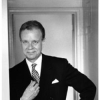Martin Filler

Martin Filler
Martin Myles Filleris a prominent American architecture critic. He is best known for his long essays on modern architecture that have appeared in The New York Review of Books since 1985, and which served as the basis for his 2007 book Makers of Modern Architecture, published by New York Review Books...
NationalityAmerican
ProfessionCritic
Date of Birth17 September 1948
CountryUnited States of America
eye age enlightenment
One of the Age of Enlightenment's most hypnotic images is Ledoux's rendering of his neoclassical theater of 1775 - 1784 in Besancon, surreally reflected in the colossal eye of an unidentified cosmic being.
dream movement architecture
One of the most persistent yet elusive dreams of the Modern Movement in architecture has been prefabrication: industrially made structures that can be assembled at a building site.
goal people use
One of the stated goals of the postmodern movement in architecture was a greater sensitivity to the people who live in or use newly designed buildings.
art construction-workers design
Nineteenth- and early-twentieth-century exponents of prefabrication were certain it would supplant age-old traditions of individualized design and handcrafted construction. The building art would be revolutionized by freeing designers and construction workers from repetitive tasks, and democratized by making high-style architecture more affordable.
years design style
By 1970, the first stirrings of the revolt against Modernist orthodoxy in architecture had been felt, although it would be several years more until Postmodernism was widely accepted and made classical motifs permissible in high-style building design for the first time in decades.
knowing self age
The first half of the 1960s was the apogee of what might be termed the Age of Cool - as defined by that quality of being simultaneously with-it and disengaged, in control but nonchalant, knowing but ironically self-aware, and above all inscrutably undemonstrative.
practice design-process office
Snohetta promotes a more democratic workplace atmosphere than most other architectural offices. This may merely reflect prevalent employment practices in Scandinavia, but Snohetta places a stronger emphasis on group participation in the design process than typical high-style firms.
technology men architecture
The tall building, concentrating man in one place more densely than ever before, similarly concentrates the dilemma of our public architecture at the end of the twentieth century: whether the new forms made possible by technology are doomed by the low calculations of modern patrons and their architects.
artist creative misunderstood
The popular mythology of creative genius depends on beloved stereotypes of the artist in youth and old age: the misunderstood upstart who forces us to see the world afresh; and the revered sage who shows us depths of insight attainable only through a lifetime of hard-won experience.
trust art integrity
What a museum chooses to exhibit is sometimes less important than how such decisions are made and what values inform them. To have the crucial role of museum professionals usurped by self-serving tycoons in the name of economic imperative threatens not only the integrity of individual institutions but the very principle of art held in public trust.
jobs winning artist
Winning the Pritzker assures a flood of work in one's seventies and eighties, jobs necessarily carried out by assistants as the demands of modern-day cultural stardom and the inevitable waning of physical capacities prevent many architects from attaining the transcendent final phase more easily achieved by artists in other mediums.
accomplishment survivor oscars
When Oscar Niemeyer died on December 5, 2012, ten days before his 105th birthday, he was universally regarded as the very last of the twentieth century's major architectural masters, an astonishing survivor whose most famous accomplishment, Brasilia, was the climactic episode of utopian High Modern urbanism.
cutting piano museums
Renzo Piano and Richard Rogers's Centre Georges Pompidou of 1971-1977 - the true prototype of the modern museum as popular architectural spectacle - wound up costing so much more than planned that the French government solved the shortfall by cutting support for several regional museums.
artist design temptation
The danger for any artist whose work is both recognizable and critically acclaimed is complacent repetition - the temptation to churn out easily identifiable, eagerly welcomed, and readily salable designs.